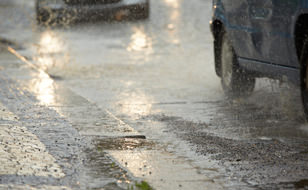Good Driving Etiquette
Useful Tips for Driving in Bad Weather
 Driving during the winter can be dangerous if you don't plan ahead. At Chill we believe in the mantra “be prepared” which is why we’ve asked our car insurance experts for some helpful tips to help you out on Irish roads during the winter months.
Driving during the winter can be dangerous if you don't plan ahead. At Chill we believe in the mantra “be prepared” which is why we’ve asked our car insurance experts for some helpful tips to help you out on Irish roads during the winter months.
So before you set out on your drive why not have a read of today’s blog to make sure you are fully prepared for anything that you might encounter on the road.
- 1. Use your lights.
- Always check your headlights and taillights are in working order before you set off. Whilst driving motorists are advised to use their dipped head lights during the day time so that they can be easily seen.
- 2. Slow down
- If you are driving in wet weather or on wet roads it can take longer to stop your car than normal. So slow down and allow extra distance between you and the car in front. It is also important to be aware of the dangers of aquaplaning on roads with speed limits over 80 km/h
- 3. Be in control
- If you are driving in high winds always be aware of your surroundings. High sided vehicles and motorcyclists can be vulnerable on the roads during bad weather so keep a safe distance. It is also advisable to take care when driving behind goods vehicles as they can create spray which can reduce your visibility.
- 4. Pay attention
- Irish drivers can be a friendly bunch and will always advise others if there are any issues on the road they have just driven on. Pay attention to the radio or to what other road users are doing in case you are coming into an area of high flooding. You should always follow recommended routes and obey signage indicating a change of route.
- 5. Watch out
- Just because it appears like the road ahead is safe it may not always be. Watch out for flooded roads that may appear shallow as they can be deeper in some areas that they appear to be. If you do happen to drive through high water, drive slowly while keeping your foot on the brakes for a short distance. This will help dry your brakes and ensure you don’t encounter any issues due to the water.
- 6. Be prepared
- Making sure your car has an emergency kit means that you are prepared for every eventuality you might encounter on the road. Some of the essentials of a good emergency kit include a high visibility vest, hazard warning triangle, de-icing equipment, a first aid kit and a working torch.
- 7. Break down etiquette
- Your car breaking down can be both frustrating and daunting if you are not sure what is happening. In the event that your car does break down there are certain things you need to ensure you do to keep you and other road users are safe. It is important that you make sure your vehicle is well off the road so you don’t obstruct other vehicles and that you have your hazard lights on. Once safe to, you should exit your car and get behind a barrier or embankment.
These simple precautions can make sure that you and those around you are safe at all times during the potential bad weather ahead.
As a Chill customer you have access to our dedicated car insurance teams via our Facebook and Twitter pages or by calling us on 01 4003400. Our friendly and helpful staff are on hand to help you with everything you might encounter.
